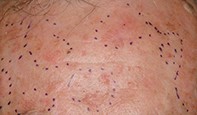Peer Reviewed
Feature Article Dermatology
Treatment of actinic keratoses – be sure first
Abstract
Actinic keratoses are clinically important because they have the potential to develop into squamous cell carcinomas. Treatment is aimed at preventing this transformation and at symptomatic and cosmetic improvement.
Key Points
- Actinic keratoses (AKs) are extremely common – about 60% of Caucasians in Australia will have at least one by the age of 40 years.
- They are localised proliferations of aberrant keratinocytes that develop most often from prolonged exposure to UV radiation but also as a result of immunosuppression, human papillomavirus infection and arsenic exposure.
- AKs may develop into squamous cell carcinomas (SCCs), and therefore are strong predictors of the subsequent development of nonmelanoma skin cancers.
- If thickening, bleeding or tenderness are present in an AK, malignancy should be excluded before treatment is commenced.
- Patients at high risk of SCC should have their AKs biopsied if there is any doubt about the diagnosis.
- The most commonly used management options for removal are cryotherapy and 5-fluorouracil cream.
Purchase the PDF version of this article
Already a subscriber? Login here.

